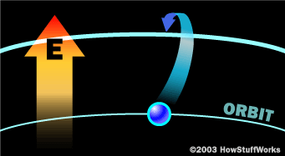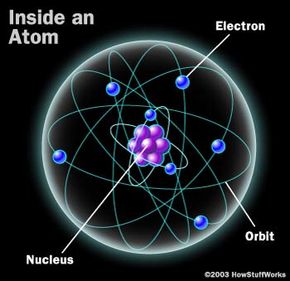Spectroscopy Basics
Spectroscopy takes advantage of the fact that all atoms and molecules absorb and emit light at certain wavelengths. To understand why, you must understand how atoms are structured. You can read about atomic structure in How Atoms Work, but a quick recap here will be helpful. In 1913, a Danish scientist by the name of Niels Bohr took Ernest Rutherford's model of the atom -- a dense nucleus surrounded by a cloud of electrons -- and made some slight improvements that better fit with experimental data. In Bohr's model, the electrons surrounding the nucleus existed in discrete orbits, much like planets orbiting the sun. In fact, the classic visual image we all have of atoms, such as the one on the right, is modeled after Bohr's concept. (Scientists have since moved away from some of Bohr's conclusions, including the idea of electrons moving around the nucleus in fixed paths, instead envisioning electrons congregating around the nucleus in a cloud.)
In the Bohr atom, an electron in a particular orbit is associated with a specific amount of energy. Unlike planets, which remain fixed in their orbits, electrons can hop from one orbit to another. An electron in its default orbit is in its ground state. To move from the ground state to an orbit farther away from the nucleus, an electron must absorb energy. When this happens, chemists say the electron is in an excited state. Electrons generally can't remain in an excited state indefinitely. Instead, they jump back down to the ground state, a move that requires the release of the same energy that enabled them to become excited in the first place. This energy takes the form of a photon -- the tiniest particle of light -- at a certain wavelength and, because wavelength and color are related, at a certain color.
Advertisement

Each element on the periodic table has a unique set of Bohr orbits that no other element shares. In other words, the electrons of one element exist in slightly different orbits than the electrons of another element. Because the internal structures of the elements are unique, they emit different wavelengths of light when their electrons get excited. In essence, every element has a unique atomic "fingerprint" that takes the form of a set of wavelengths, or a spectrum.
William Wollaston and Joseph von Fraunhofer developed the first spectrometer to see the spectral fingerprints of elements. A spectrometer is an instrument that both spreads out light and displays it for study. Light enters a narrow slit and passes through a lens that creates a beam of parallel rays. These rays travel through a prism, which bends the light. Each wavelength is bent a slightly different amount, so a series of colored bands is produced. A second lens focuses the light on an exit slit, which allows one color of light to pass through at a time. Scientists often use a small telescope, mounted on a turntable, to observe the color exiting through the slit more easily. Then, the scientist rotates either the telescope or the prism to bring another color into view. By noting the angle of the prism or the telescope, the wavelength of the exiting light can be determined. Using a spectroscope to analyze a sample may take several minutes, but it can reveal much about the light source. Some spectrometers, known as spectrographs, are set up to photograph the spectrum.
As you'd expect, the spectrometer is an essential tool for chemists conducting laser spectroscopy. Next, we'll briefly look at some of the most important types of laser spectroscopy.
